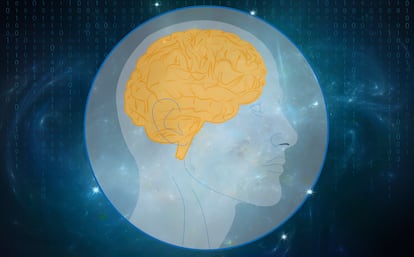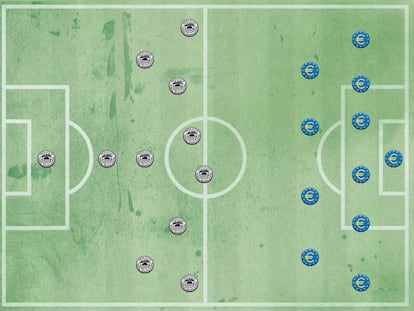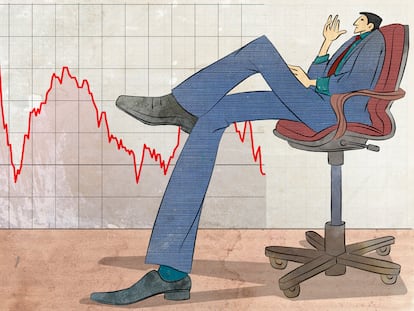The economics of artificial intelligence
Technological progress is a source of growth and jobs, but we need to be prepared to make the most of it

The brain is a generator of automatisms, which allow us to do things even though we can’t explain how we do them. The goalkeeper who dives to clear that ball in the corner, the gymnast who throws the ribbon and catches it without looking after several somersaults, the tennis player who connects the passing shot on the run. None of them think about (or know), while executing these movements, the mathematical model or the laws of physics that determine these trajectories, yet nevertheless, based on some basic concepts and millions of repetitions, they are capable of doing them.
But sometimes, something happens that truncates that ability. Like Simone Biles at the Tokyo Olympics, sometimes the brain loses its automatisms. The gymnasts lose their axis, the golfers their swing, the tennis players their serve. The concepts have not been forgotten, but the automatisms fail. And if you have to think, it no longer works. To recover, they have to slowly rebuild their automatisms, until they are able, once again, to play without thinking.
Computers, unlike the brain, need explicit models. In order to send a rocket to the Moon, complex trajectories are designed with high precision. And to study the effect of an economic policy measure, a mathematical model is designed that simulates the functioning of the economy. Computers need instructions, they do not know how to generate automatisms. That’s how they differ from humans.
Artificial intelligence started like this, giving instructions to the computer. To translate a document, a model was designed that replicated the grammar of the language. To play chess, a program was designed that replicated the rules of the game. But it soon became clear this road was very limited. How do you write a program to teach a computer what a cat is? Or to detect a tumor on an X-ray? Human intelligence is different, it does not work with models. A baby is not taught to recognize the face of her parents. But after a few days, by dint of seeing them, she is able to do it.
Data is also the limit of artificial intelligence, because the power of an algorithm is limited to its database. That’s why artificial intelligence replaces tasks, not jobs or business strategies
That’s because the brain is a machine for predicting the immediate present, based on trial and error. Each action and its consequence generate a neural connection, each repetition of that action reinforces that neural connection, and based on repetitions the connection is consolidated and the brain “learns.”
Artificial intelligence has evolved towards the prediction of the present. The immense improvement in the processing capacity of computers, and the exponential increase in the data available for analysis – more than 90 percent of the data available today has been created in recent years – makes it possible for computers to operate in a similar way to the brain.
Text translation is done based on the analysis of millions of translations, and the computer “learns” to predict which word or phrase in one language is related to another in another language. Facial recognition takes advantage of the digitization and tagging of millions of photos, which enables relational analysis of images. Autonomous driving systems are built with the digitization and analysis of the actions of human drivers, to be able to predict and replicate their behavior. Any activity that can be digitized and tagged can be turned into a prediction exercise, and therefore automated.
Artificial intelligence reaches the most unexpected corners. For example, this summer I witnessed how, in one of the most famous Rioja wineries in Spain, harvested grapes that are in poor condition are no longer discarded manually, but with an artificial intelligence system: the computer has been trained to recognize images of grapes in poor condition, the cameras detect them on the conveyor belt and activate a system of pressurized air jets that eliminates them before reaching the pressing barrel.
Computers perform arithmetic and probability analysis better than humans, but humans are superior in value judgments and intangible decisions
The economics of artificial intelligence is the economics of prediction. The computer reduced the cost of arithmetic operations, making the prediction process cheaper. The improvement of internet connections exponentially expanded the volume of data available to apply this arithmetic. The combination of more powerful computers and faster internet connections makes the system globally scalable, making prediction infinitely cheaper and more accurate, allowing many activities to be converted into prediction exercises.
Data, be it images, videos, or texts, is the raw material of artificial intelligence, the fundamental element for learning and training algorithms. Every time you send a message or upload a photo to the internet you are helping develop or improve artificial intelligence algorithms. The famous cookies, and internet searches, capture patterns of digital behavior that will serve as training for algorithms. Data regulation is not just a matter of privacy, but also of ownership of this fundamental raw material.
Data, in the world of statistics and econometrics, shows diminishing returns: once a model is estimated, one more data point does not materially improve its prediction ability. But in the world of artificial intelligence, data shows increasing returns: with little data you cannot do facial recognition, or autonomous driving systems. But the accumulation of data at some point makes it possible and economically viable, and from there the improvements are exponential. This explains the interest of technology companies in companies that, although not profitable, are generators of data. The exclusivity of the data, more than the details of the algorithms, is the key to success in artificial intelligence.
Data is also the limit of artificial intelligence, because the power of an algorithm is limited to its database. That’s why artificial intelligence replaces tasks, not jobs or business strategies. The key to technological progress is the combination of machines and humans. The best chess players are not humans, nor computers, but humans with the help of computers. Computers perform arithmetic and probability analysis better than humans, but humans are superior in value judgments and intangible decisions, because the accumulated experience in their brains – their database – is far superior in quantity and especially in diversity to that of computers. And that allows them to react to an unforeseen event for which the algorithm was not trained. It also facilitates creativity, which almost always springs from interdisciplinary connections – think of molecular cuisine, for example. Therefore, it is essential to educate citizens so that they know how to operate with computers – computing should be as mandatory as a second language – but without forgetting the humanistic subjects and abstract reasoning that provide that agility and creative advantage.
Technological progress is the source of growth and, therefore, of job creation. But you have to be well prepared to take advantage of it.
Twitter: @angelubide
Tu suscripción se está usando en otro dispositivo
¿Quieres añadir otro usuario a tu suscripción?
Si continúas leyendo en este dispositivo, no se podrá leer en el otro.
FlechaTu suscripción se está usando en otro dispositivo y solo puedes acceder a EL PAÍS desde un dispositivo a la vez.
Si quieres compartir tu cuenta, cambia tu suscripción a la modalidad Premium, así podrás añadir otro usuario. Cada uno accederá con su propia cuenta de email, lo que os permitirá personalizar vuestra experiencia en EL PAÍS.
¿Tienes una suscripción de empresa? Accede aquí para contratar más cuentas.
En el caso de no saber quién está usando tu cuenta, te recomendamos cambiar tu contraseña aquí.
Si decides continuar compartiendo tu cuenta, este mensaje se mostrará en tu dispositivo y en el de la otra persona que está usando tu cuenta de forma indefinida, afectando a tu experiencia de lectura. Puedes consultar aquí los términos y condiciones de la suscripción digital.
More information
Últimas noticias
Most viewed
- Reinhard Genzel, Nobel laureate in physics: ‘One-minute videos will never give you the truth’
- Oona Chaplin: ‘I told James Cameron that I was living in a treehouse and starting a permaculture project with a friend’
- Pablo Escobar’s hippos: A serious environmental problem, 40 years on
- Why we lost the habit of sleeping in two segments and how that changed our sense of time
- Charles Dubouloz, mountaineering star, retires at 36 with a farewell tour inspired by Walter Bonatti











































